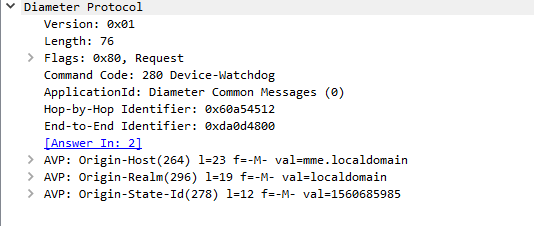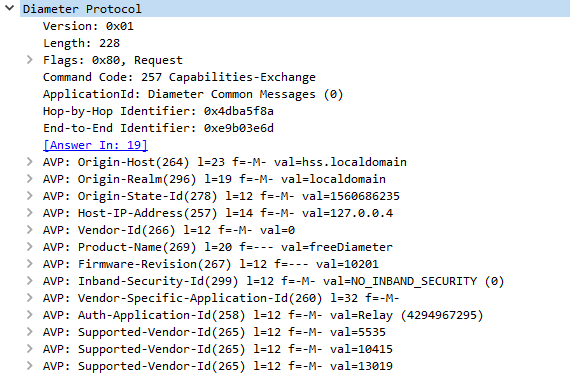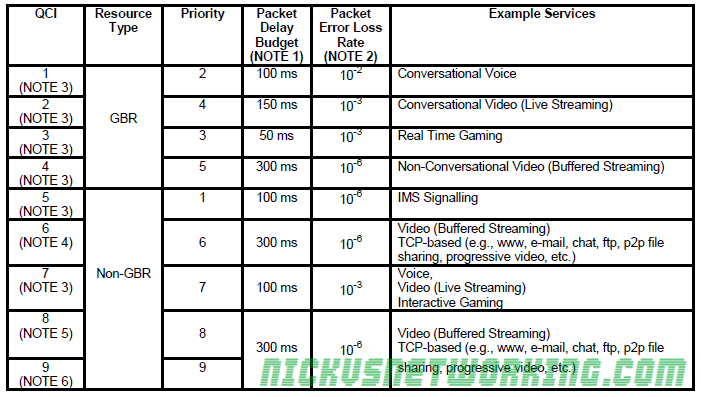We talked a little about what the Diameter protocol is, and how it’s used, now let’s look at the packets themselves.

Each Diameter packet has at a the following headers:
Version
This 1 byte field is always (as of 2019) 0x01 (1)
Length
3 bytes containing the total length of the Diameter packet and all it’s contained AVPs.
This allows the receiver to know when the packet has ended, by reading the length and it’s received bytes so far it can know when that packet ends.
Flags
Flags allow particular parameters to be set, defining some possible options for how the packet is to be handled by setting one of the 8 bits in the flags byte, for example Request Set, Proxyable, Error, Potentially Re-transmitted Message,
Command Code
Each Diameter packet has a 3 byte command code, that defines the method of the request,
The IETF have defined the basic command codes in the Diameter Base Protocol RFC, but many vendors have defined their own command codes, and users are free to create and define their own, and even register them for public use.
3GPP have defined a series of their own command codes.
Application ID
To allow vendors to define their own command codes, each command code is also accompanied by the Application ID, for example the command code 257 in the base Diameter protocol translates to Capabilities Exchange Request, used to specify the capabilities of each Diameter peer, but 257 is only a Capabilities Exchange Request if the Application ID is set to 0 (Diameter Base Protocol).
If we start developing our own applications, we would start with getting an Application ID, and then could define our own command codes. So 257 with Application ID 0 is Capabilities Exchange Request, but command code 257 with Application ID 1234 could be a totally different request.
Hop-By-Hop Identifier
The Hop By Hop identifier is a unique identifier that helps stateful Diameter proxies route messages to and fro. A Diameter proxy would record the source address and Hop-by-Hop Identifier of a received packet, replace the Hop by Hop Identifier with a new one it assigns and record that with the original Hop by Hop Identifier, original source and new Hop by Hop Identifier.
End-to-End Identifier
Unlike the Hop-by-Hop identifier the End to End Identifier does not change, and must not be modified, it’s used to detect duplicates of messages along with the Origin-Host AVP.

AVPs
The real power of Diameter comes from AVPs, the base protocol defines how to structure a Diameter packet, but can’t convey any specific data or requests, we put these inside our Attribute Value Pairs.
Let’s take a look at a simple Diameter request, it’s got all the boilerplate headers we talked about, and contains an AVP with the username.

Here we can see we’ve got an AVP with AVP Code 1, containing a username
Let’s break this down a bit more.
AVP Codes are very similar to the Diameter Command Codes/ApplicationIDs we just talked about.
Combined with an AVP Vendor ID they define the information type of the AVP, some examples would be Username, Session-ID, Destination Realm, Authentication-Info, Result Code, etc.
AVP Flags are again like the Diameter Flags, and are made up a series of bits, denoting if a parameter is set or not, at this stage only the first two bits are used, the first is Vendor Specific which defines if the AVP Code is specific to an AVP Vendor ID, and the second is Mandatory which specifies the receiver must be able to interpret this AVP or reject the entire Diameter request.
AVP Length defines the length of the AVP, like the Diameter length field this is used to delineate the end of one AVP.
AVP Vendor ID
If the AVP Vendor Specific flag is set this optional field specifies the vendor ID of the AVP Code used.
AVP Data
The payload containing the actual AVP data, this could be a username, in this example, a session ID, a domain, or any other value the vendor defines.
AVP Padding
AVPs have to fit on a multiple of a 32 bit boundary, so padding bits are added to the end of a packet if required to total the next 32 bit boundary.








